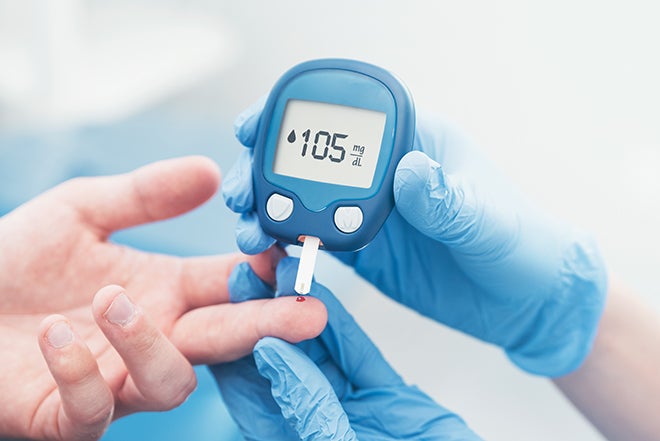Apple employees who participated in internal testing of the app were required to prove they were prediabetic by taking a blood test that showed they were at risk for type 2 diabetes, although they did not currently have the disease. People with type 1 diabetes produce little or no insulin as a result of an autoimmune disease that starts affecting the pancreas at a young age. The main treatment for type 1 diabetes is insulin injections.

Glucose meters measure blood sugar levels in diabetics by pricking blood onto a disposable test strip. |Image credit-PatientsEngage
Type 2 diabetes is usually caused by genetics and/or lifestyle decisions. Insulin production is normal at first, but then decreases. Type 2 diabetes develops when patients are older, and treatment includes lifestyle changes, medications, and insulin. Again, Apple employees who tested the app had to demonstrate that they were at risk for type 2 diabetes. These employees monitored their blood sugar levels using commercially available devices, such as glucometers, which require blood to be drawn from a finger using a sharp instrument called a lancet.
The blood is placed onto expensive disposable test strips that are already placed in the slot of the glucometer. After blood is applied to the strip, it takes a few seconds for the glucometer to display the user's blood sugar reading. This number determines the amount of insulin that diabetics must take before each meal.
Additionally, the Apple Watch's non-invasive blood glucose sensor helps diabetics detect when their blood sugar levels become dangerously low, a condition known as hypoglycemia, which can cause diabetics to pass out or go into a coma. may give a warning. Drinking sugary juices or eating sugar-rich candy bars can help bring blood sugar levels back to normal levels in diabetics. Apple appears to have made some progress towards sensor development, but that's still years away.
Apple's non-invasive blood glucose sensor uses a laser to shine light onto the skin and read the amount of glucose in the user's blood. The first iteration of the feature may only warn if the user is prediabetic. Subsequent versions will provide users with specific blood sugar readings and allow diabetics to use this feature to calculate how much insulin they need to inject before meals.
It's not uncommon for Apple to use employees to test blood sugar apps it's developing, and the company recently used employees to test the Apple Watch's new sleep apnea feature. The same strategy will be used by Apple to develop a high blood pressure detection feature for the Apple Watch that will alert the wearer of the device when their blood pressure is high.


